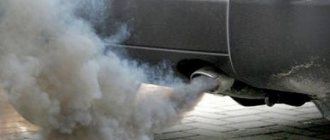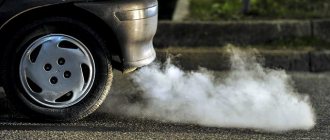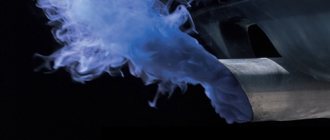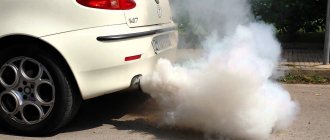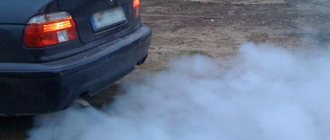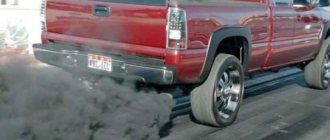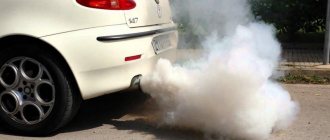White smoke from the exhaust pipe is a common occurrence in winter, so, as a rule, few people pay attention to it, but in the summer, when it is warm, thick white exhaust is alarming, both for owners of diesel cars and cars with a gasoline engine. Let's figure out why white smoke appears from the exhaust, whether the reasons are dangerous , and how to find out its origin .
Harmless smoke, or rather white steam, should not have a special odor, since it is formed due to the evaporation of accumulated condensate in the exhaust system pipes and in the engine itself at an air temperature below +10°C. Therefore, it should not be confused with smoke, which will indicate problems in the cooling system or the engine itself.
White smoke is a sign of increased humidity in the exhaust system
. After the engine warms up, the steam and condensate disappear, but if smoke still comes out of the exhaust, then this is a sign of engine malfunction.
The smoke coming from the muffler should be colorless
.
White smoke from the muffler - what is it?
A car - a harmonious system of components and assemblies - like a living organism, sends signals to the owner about various types of malfunctions. However, not every owner reacts to such a “trifle” as thick white smoke from the exhaust pipe of a gasoline engine. Meanwhile, the color of the exhaust, the frequency of the phenomenon (short-term or frequent) are harbingers of serious repairs: sometimes it comes to capital.
Exhaust gases consist of water vapor and many chemical compounds, the main ones being a mixture of nitrogen and carbon dioxide. Before being released into the atmosphere, spent substances are purified in a catalyst.
Why is white smoke from the exhaust pipe dangerous?
If the car is in order, the gases are colorless. A small cloud of whitish smoke when the power plant is cooling, as well as when starting the internal combustion engine in cold weather, should not bother the driver. Rather, steam is released: water, a byproduct of gasoline combustion, condenses in the cold exhaust tract and becomes visible. This picture is considered normal.
It’s worse when a dense white trail trails behind the car on a warm day, and the engine is warmed up to operating temperature. Analysis of the phenomenon in most cases indicates technical malfunctions of the vehicle.
Black smoke
The appearance of black smoke from the exhaust pipe does not indicate a major breakdown of the engine or other systems. But if the cause of this phenomenon is not eliminated in a timely manner, then this can really lead to serious problems with the engine, ignition system and supply system.
The formation of black smoke indicates an oversaturated fuel-air mixture. Such a large amount of fuel enters the cylinders that it does not have time to burn effectively, which is why the exhaust becomes dark in color. Such exhaust is much more toxic than the ordinary exhaust of a properly running car.
The main cause of black smoke is a malfunctioning fuel supply system. The reason may also be a malfunction of the ignition system, as a result of which the fuel does not ignite inside the chamber, which is why the mixture comes out in a raw state through the muffler. Another characteristic of such a case is that the engine will “trouble” a lot.
If the exhaust is gray-black, this may indicate that the carburetor is not working properly. Often the reason lies in the overflow of the float chamber.
- This may occur due to a faulty needle valve, which may allow excess fuel to pass through or, on the contrary, stick.
- The jets may be clogged.
To fix such problems, you need to disassemble the carburetor and clean it thoroughly. If this does not help, then you should buy a repair kit, replace the jets and needle valve and correctly set the gasoline level inside the chamber.
In the case of an injection engine, the problem can be solved by cleaning the injector itself. It may also be necessary to replace the fuel pump or one of the sensors that monitor various cycles. In the second case, it is unlikely that you will be able to solve the problem on your own; you will have to go to a workshop, where, using special equipment, they will be able to correctly diagnose the faulty element and replace it.
The main reasons for the appearance of white smoke from the exhaust pipe of a gasoline engine
It is important to be able to distinguish between harmless water vapor and smoke itself. The steam easily, without a trace, disappears into the air, while the smoke turns into an oily bluish fog behind the car. Let's consider the causes of white smoke from the exhaust pipe of a gasoline engine in order to correctly estimate the costs of restoring the mechanisms and systems of the car.
Leaking coolant cylinder
Drivers consider the cylinder block to be the most important component in the design of a car, which always requires attention.
The BC can depressurize for several reasons:
- gasket burnt out;
- the cylinder head was deformed due to improperly tightened nuts;
- A crack appeared in the cooling jacket of the unit.
The last trouble occurs due to the negligence of drivers who add cold water to a hot engine or defrost the unit when the thermometer is very negative. Antifreeze gets into the cylinders of a leaking block: white smoke comes out of the muffler. Other symptoms also appear:
- the motor lubricant becomes cloudy, a light yellow-brown emulsion appears in it, which is easy to notice in the filler neck;
- bubbles form in the expansion tank;
- the spark plugs get wet, smell like antifreeze, but sparkle like new: the working fluid cleans the parts perfectly;
- the power unit is tripping.
Causes of light white smoke
The danger of coolant leaking into the cylinders is that ethylene glycol (a component of antifreeze and antifreeze) mixes with the engine lubricant and forms solid particles. The latter, acting as an abrasive, destroys parts. And the lubricant loses its qualities. Taken together, these circumstances put the entire unit out of working order.
Injector malfunction
Both cars with injectors (Toyotas, Renault, Peugeot) and equipment with carburetors (motorcycles, walk-behind tractors, scooters) smoke.
The causes of white smoke from the muffler are as follows:
- the supply of the air-fuel mixture or the operation of the gas distribution mechanism is disrupted, which leads to incomplete combustion of gasoline;
- components of the cylinder-piston group are worn out;
- There were problems with engine cooling.
The last reason is the most likely for injection engines. Additionally you will notice:
- increased fuel consumption;
- oil zhor;
- floating speed;
- Difficulty starting an unheated unit.
The smoke from steam in injectors is characterized by high density, the smell of burnt oil, and long dissipation. It’s a completely alarming signal when the smoke does not disappear after the car warms up.
White smoke due to condensation
The exhaust tract, after standing overnight, becomes covered with drops of moisture. Condensation actively forms on metal in cool weather, when the thermometer is below +10 °C. High air humidity also contributes to the appearance of moisture in the muffler.
During the morning warm-up, the components of the exhaust system become hot, the exhaust gases mix with droplets of water, forming steam. As the condensate evaporates, the white smoke disappears.
Low-quality gasoline with foreign impurities
Some drivers save on gasoline or diesel and fill the tank with cheap fuel at dubious gas stations. So you risk paying for water that will freeze in winter and seal the fine mesh of the fuel filter, plus excess sulfur. In the combustion chambers, the substance turns into sulfur oxide, then, mixed with water vapor, into sulfuric acid. The consequences for the engine will be catastrophic.
The octane number in “left-handed” gasoline is not controlled, causing destructive detonation. And it contains toxic benzene and aromatic carbohydrates, which increase carbon deposits and “eat” rubber and plastic. Alcohols and ethers create air pockets in fuel lines.
Why does the chimney smoke white?
The following systems suffer from low-quality gasoline: intake-exhaust, fuel supply, exhaust, ignition. In addition to detonation, poor car starting, loss of power, you will hear knocking in the engine and see a darkish exhaust in the rearview mirror.
Oil burnout due to the presence of rings (smoke with a tint)
Remaining engine oil from valve stems and cylinder walls is removed by valve stem seals and rings. Worn rings become stuck, so excess lubricant burns out.
At the initial stage, the defect is noticeable when climbing uphill with the gas pedal pressed halfway. A bluish haze appears and quickly dissipates. In critical cases of oil scraper rings, smoke accompanies the car constantly, most of all when accelerating.
Moisture getting into the cylinders
By “moisture” we mean coolant. Look for the reasons why white smoke is coming out of the exhaust pipe in defects in the block or cylinder head. Most likely these are cracks.
For an accurate diagnosis, remove the cap from the expansion tank and start the engine. Now examine the fluid for oil stains and a specific exhaust odor. The detected signs indicate microcracks or wear of the BC gasket.
To be afraid or not
To begin with, I propose to understand the main points. Here it is important to distinguish when steam really poses a potential threat, that is, it indicates a malfunction, and when there is absolutely nothing to be afraid of.
If we are talking about absolutely safe and harmless smoke, then it should be white, have no odor and no traces of impurities. When the situation develops this way, we are talking about water vapor. Condensation has formed in the exhaust system, that is, a fairly large amount of moisture has accumulated. Now this water begins to actively evaporate due to gradual heating. It all turns into steam. It is in steam that this is important to remember. Because there is another concept. I'm talking about white smoke.
If we see such a picture when white smoke comes out of the exhaust, then it makes sense to suspect the engine or cooling system of some kind of malfunction.
During normal engine operation, the smoke coming out of the chimney should be transparent or close to it. However, on older cars and rather worn-out engines, the smoke becomes more toxic and dirtier.
What's the result?
Do not forget that some cars do not have a catalyst, and this entails additional pollution, since the exhaust gases skip the pre-treatment stage before exiting.
If this element is present, then checking the catalyst for clogging will be your first priority.
Let's sum up the intermediate results. If white smoke is coming out of your car's exhaust pipe, this indicates high levels of moisture inside the exhaust system. It is important to pay close attention to this nuance. When the engine warms up, all the water should evaporate. Therefore, steam and condensate no longer come out of the pipe. But if the engine has warmed up and smoke continues to pour out, then this is an obvious sign of a problem. Something needs to be done. First, find out the reasons.
There are several possible reasons for this situation.
Let's look at them, and take a separate look at the features of diesel and gasoline internal combustion engines.
How to fix a fluid leak
Remove the cylinder head and block, inspect the gasket: most often the matter ends with replacing the consumables. Next, check the block for leaks: look for leaks near the valve seats, examine the cylinders one by one. If a leak is found, replace the defective parts.
However, the working fluid enters the cylinders in a different way - through the fuel intake system. It is difficult to detect the problem: there is no burning smell, the pressure is normal, but the lubricant turns into an emulsion, and the liquid level drops. There is no need to dismantle the cylinder head: inspect the intake manifold, find the place where the coolant leaks into the “pants”.
Let's sum it up
Any problems with the car’s fuel system need to be repaired with the help of specialists. In modern cars, disassembling the engine in a garage can result in a real problem that will force you to urgently call specialists to troubleshoot problems. If you do not want to receive the unpleasant consequences of handicraft work, it is better to immediately contact a good service station for high-quality diagnostics.
There may be nothing wrong with the steam coming out of your car's chimney. But once again confirming the safety of operation with high-quality diagnostics will not be superfluous. Has a similar situation happened to your car and how did it end?
Why does white smoke appear from the exhaust pipe of a gasoline engine?
The exhaust tract is one of the mandatory modules of cars with internal combustion engines. In addition to the main task - removing exhaust gases - the system reduces noise from the operation of the internal combustion engine and the visibility of exhaust emissions. The latter, however, can be clearly expressed. Sometimes it’s just a physical law, in other cases it’s a signal of inevitable expensive repairs.
In the cold
If you start the car early in the morning at an ambient temperature below +8-10 ° C, then white smoke from the exhaust pipe of a gasoline engine will appear in the form of condensation in the metal pipes of the exhaust system. The phenomenon will become more noticeable the lower the thermometer drops.
Why did the car start smoking white?
The explanation is as follows: droplets of moisture (condensation) have settled on the inside of the muffler, the driver turns on the ignition, accelerates: hot gases rush into the pipe. The muffler heats up, the condensate passes into the gaseous phase - steam, visible to the eye.
On startup
And again physics - condensation in the muffler. Often there is so much moisture that it drips from the exhaust pipe. The shorter the trips and the more frequent the stops, the more intense the droplets are formed: in 15-20 minutes of driving the water will not evaporate completely. In the cold season, it is recommended to drive the car for at least half an hour every 7-10 days or warm it up thoroughly.
When warming up (hot)
When the car is completely warmed up and the cloud does not disappear, car mechanics advise making sure that antifreeze does not get into the combustion chambers. First you need to check the gasket, then the integrity of the cylinder head.
The causes of white smoke from the exhaust pipe of a gasoline engine when hot can also be:
- thermostat failure;
- inoperative fan;
- depressurization of the radiator and connecting hoses.
If a warm engine smokes, you won’t be able to ignore the problem: immediately diagnose the car and eliminate the defects.
When you accelerate
Look at the thermometer: if the mercury drops below +10 degrees, and it is damp outside, the natural process of evaporation of condensate comes into play. You press the gas pedal, more fuel mixture is injected into the combustion chambers. This means that the exhaust will be more energetic. The muffler gets very hot, moisture evaporates from the walls.
However, the picture changes in the warm season, when both temperature and air humidity are normal. You give it gas, but the white smoke from the exhaust pipe on a warm engine does not disappear. Urgently take the car to a car service center: most likely, the fault will be due to impaired coolant circulation.
At high speeds
You can't blame the weather if clouds of smoke are emitted through the exhaust pipe at high speeds. The reason may lie in the coolant, which has somehow penetrated the power system.
How to remove white smoke
Let's look at the problem in more detail.
The influence of the quality of the oil used on smoke formation
Motor oil must have certain characteristics. The quality of the lubricant used directly depends on its properties. If the car engine contains low-quality oil, the viscosity coefficient of which does not correspond to the car brand, or if the temperature inside the engine increases, a sharp loss of useful properties of the lubricant occurs, this leads to serious damage to the elements and systems of the power unit. If blue smoke appears, you need to check the oil for compliance and, if necessary, completely replace it.
The appearance of smoke can be caused by a number of other reasons - from the appearance of microcracks in the engine body to the use of the wrong type of fuel intended for a given engine brand. Each specific situation always has a solution when seeking help from qualified specialists.
Source
Thick white steam does not stop and intensifies with increasing speed
In an automotive design, the channels of movement of the working fluid (antifreeze, antifreeze) pass quite close to the power unit. Under the influence of high temperature or vibration, the boundaries of the two systems are destroyed: serious malfunctions appear.
Fatigue of the gasket between the head and the cylinder block
The seal is the weak point of the cylinder head and the eternal concern of engineers. You can’t do without a removable head, so developers are constantly strengthening the gaskets. In “Mercedes”, “Lacetti”, “Mazda” the part is made as a composite part, consisting of several metal sheets. In this case, the gasket is firmly pressed with a dozen bolts. But temperature changes and metal fatigue lead to holes through which coolant at the inlet enters the combustion chambers.
In addition to white smoke from the muffler pipe, the phenomenon is accompanied by several characteristic signs:
- the expansion container “boils”;
- antifreeze constantly “disappears”;
- the engine overheats due to vapor locks even without heavy loads;
- The cabin heater does not heat properly;
- The radiator emits a slightly sweet smell.
An endoscopic examination or pressure testing of the cylinders with compressed air shows: the piston heads, washed with antifreeze, shine with cleanliness, which is far from the best indicator.
Gasket burnouts
Gaps in consumables appear if you have saved on it or violated the repair technology.
Advice from experienced people:
- take a high-quality critical part: do not use soft options edged around the combustion chambers (reinforced paronite) instead of the metal gaskets recommended by the manufacturer;
- do not reuse the part by patching burnouts;
- tighten the spare part with a torque wrench according to the instructions for the specific motor;
- do not rely on the tightening torque and tighten the part if required by the manufacturer;
- check for deformation and, if necessary, grind the planes of the head and block.
Non-standard gaskets quickly burn out and emit white smoke from the muffler.
Burnouts on the surfaces of the cylinder head and block
The cylinder block and cylinder head are two important components of a car's power plant. Between them there is a gasket, the reasons for the holes of which have already been discussed above. It remains to understand why the sealing of the components is still broken, due to which the coolant enters the combustion chambers, and a smoke trail stretches behind the car.
It's all about engine overheating, the list of reasons for which is not limited to one dozen:
- insufficient coolant;
- The radiator is not working efficiently (for example, the fan belt is loose);
- The thermostat has failed;
- the ignition angle is incorrectly set;
- prolonged detonation, one of the reasons for which is low-quality fuel;
- a lot of mineral salts from antifreeze or water have been deposited on the cylinder head cavity;
- uncontrolled independent use of additives in motor oil.
The lists can be continued, but the result is the same - the engine overheats, the surfaces of the block and cylinder head burn out, which is immediately indicated by white smoke from the exhaust pipe on a warm engine.
Corrosion and cracks
Rust on the surfaces of the block and head is an inevitable phenomenon. But microcracks – the entrance gates for coolant – also form quite often.
Causes of defects:
- the block was poorly washed and purged before assembly;
- vibration;
- air lock due to the fact that the expansion tank cap valve does not hold pressure;
- overheating of the engine with subsequent deformation.
How to detect cracks:
- Install magnets on the case, sprinkle metal shavings. The particles will move towards the magnet, getting lodged in the cracks.
- Wipe the surfaces with acetone, apply a special paint: when you wipe off the residue, the cracks will clearly appear.
Defects can be eliminated by electric or electric arc welding, epoxy paste, or patch welding. However, in some places (valve seats, cylinder mirrors, planes of connection between the block and the head) it will not be possible to repair cracks: the modules will have to be replaced.
Carbon-effect film for cars: which one to buy, how to glue it yourself
Now let's look at gasoline car engines. As with diesel, it is quite normal to see white steam in cold and wet weather. The engine warms up, sometimes even water drips from the pipe. But as soon as the motor reaches its operating temperature, this phenomenon should disappear.
If this does not happen, there are problems. You need to look for them.
Gasoline engines are characterized by the following problems in the presence of white smoke:
- coolant enters the cylinders;
- the injector has failed;
- low quality fuel;
- gasoline contains impurities;
- The rings are stuck and the oil is burning out.
The latter option will be accompanied by the appearance of smoke with a slight tint, that is, it will not be completely white.
How to determine why white smoke is coming from the exhaust pipe of a gasoline engine
Look into the expansion tank to see if there is any sediment or emulsion film there. Sniff: a foreign smell from the container is a bad sign.
Check the level and condition of the engine oil: there should be no water in the lubricant. Unscrew the spark plugs: carbon deposits are found - the fuel does not burn completely. Some experienced technicians, if the spark plugs are wet, taste the liquid on their tongue: a sweet taste means antifreeze has entered the system.
Paper check
Determine the nature of the exhaust (steam or smoke?) using a clean sheet of paper or a white napkin. Start the car and let the engine run for a short time. Bring the stored items to the muffler (do not lean close to it).
White smoke is pouring out
Examine the imprint left behind:
- if there is water in the pipe, the paper remains clean and will soon dry;
- if it is oil, you will see a greasy stain;
- Coolant will leave a blue or yellow mark.
The components on the napkin will emit a specific odor.
Emulsion on the lid
The coolant contains ethylene glycol. If, due to depressurization of the oil and cooling circuits, the components are mixed, an emulsion is formed. You can see the dangerous substance under the expansion tank cap: light foam or film will collect here.
Radiator grille: DIY tuning
To check you need to do this:
- open the cap on the expansion tank;
- or open the cap on the radiator;
- see if there is an oil film there;
- smell the liquid in the tank for signs of exhaust;
- check for bubbles in the tank;
- observe whether the coolant level increases when starting the engine;
- and does it decrease after turning off the internal combustion engine;
- check the pressure build-up in the cooling system.
If you find traces of antifreeze in the engine, you should not continue using the diesel engine. Otherwise, the situation can worsen.
Consequences for the engine if thick white smoke starts
Finding the cause of white smoke from the exhaust pipe of a gasoline engine is half the battle. It is important to understand the consequences and eliminate defects, since the latter quickly progress, destroying engine components.
With a thick white cloud astern, you can drive a few hundred kilometers: then you need to carry out detailed diagnostics of the power unit. At the initial stage, it may be necessary to replace the gasket, repair cracks in the block or head, and eliminate coolant leaks into the oil circuit. If you do not pay due attention to emissions from the exhaust tract, a major engine overhaul cannot be avoided.
Why this problem cannot be ignored
If white smoke comes from the exhaust pipe, which is a consequence of a malfunction of some vehicle elements in the internal combustion engine, you must act quickly. Mixing antifreeze and oil is a useless emulsion that has low lubricating properties. A protective film still forms on the cylinder walls, however, it is not of the required quality. All this leads to the formation of carbon deposits, burnout of cooling and lubricants and rapid wear of various structural elements. If no action is taken, the engine will run almost dry, which will sooner or later lead to a wedge.
Engine smoke: causes and solutions
The appearance of smoke can be associated with malfunctions of various engine systems and operating components: power system, cooling system, ignition system, injection control system, cylinder-piston group, distribution mechanism, and so on. According to the cause of the malfunction, smoke occurs either due to incomplete or improper combustion of fuel, or due to coolant entering the cylinders, or due to oil entering there, which gives the exhaust gases a characteristic color. Often, a malfunction of one system that turns out to be a source of smoke occurs due to problems and defects in another. Here is a typical example: poor performance of the cooling system leads to overheating of the engine and, accordingly, burning of the piston rings. As a result, oil gets into the cylinders, which causes smoke. It is better to start searching for the cause by comparing all visible circumstances: the nature of the smoke itself, observed accompanying phenomena, and the possible influence of the external environment. There is an opinion among experienced motorists that by the color of the smoke from the exhaust pipe you can determine which engine malfunction is causing it.
Many people are familiar with the following situation: you start the engine after a long stop, and thick smoke comes out of the exhaust pipe. And even when warming up, the amount and color of the smoke may decrease, and even disappear completely when driving. But more often it happens differently. The smoking continues, the color of the smoke remains the same and clearly indicates that there is some kind of problem in the heart of the car (engine). And the reason for this is not the long stop, but other reasons, and at the same time, the long inaction only served as an impetus that aggravated the problems or led to their sharp manifestation.
Smoke from the exhaust pipe can be white, blue, black and any shade in between. Color serves as an important diagnostic feature. Engine operation with increased smoke is often accompanied by other deviations from the norm, although sometimes subtle ones that the driver pays attention to only when smoke of one color or another appears. Therefore, such signs should definitely be noticed and noted in order to more accurately assess the condition of the serviceability and performance of the engine.
If we analyze possible malfunctions, it turns out that in many situations the smoke is the same color, although it has different causes. Let us first consider this issue in general terms, and then we will analyze each specific case in more detail and make this visual malfunction point us to more serious defects hidden from view, i.e. We can determine the condition of the car engine by the color of the exhaust.
Why does diesel smoke when cold?
The exhaust of a working engine is transparent. If it is thick and tinged, then this is a sign of trouble:
- The injectors are clogged with low-quality fuel resins.
- The air filter is clogged.
- Turbocharger malfunction due to manifold leakage or air duct failure.
- Incorrect injection angle of the injection pump.
- Problem with glow plugs.
In most of these cases, diesel fuel is difficult to ignite and burns partially. In addition, these defects lead to a drop in engine power.
Blue or gray smoke
The most likely cause of blue (“oil”) smoke is oil getting into the engine cylinders. “Oil” smoke can have different color shades: from transparent blue to thick white-blue. This depends on the operating mode of the engine, the degree of its warming up and the amount of oil entering the cylinders, as well as lighting and other factors. It is noteworthy that oil smoke, unlike steam, does not dissipate quickly into the air, and the paper test mentioned above produces greasy droplets flying out of the pipe along with the exhaust gases. It is also obvious that oil smoke is accompanied by increased oil consumption. Thus, at a consumption of about 0.5 l/100 km, bluish smoke appears mainly in transition modes, and when it reaches 1.0 l/100 km, also in uniform motion modes. By the way, in the latter case, during transient conditions, oil smoke becomes thick blue-white. True, owners of the most modern cars need to remember about the possible presence of a neutralizer that can clean the exhaust gases from oil even at fairly high costs.
Oil can enter the combustion chambers (cylinders) in two ways: from below, through the piston rings, from above, through the gaps between the valve stems and guide bushings. The most likely reason for the appearance of blue exhaust is wear of the cylinder-piston parts. The upper compression rings experience wear not only on the outer surface in contact with the cylinder, but also on the end planes that perceive the gas pressure in the cylinder. The grooves of these rings in the pistons may also be worn out. Large gaps in the grooves create a pumping effect. Even if the oil scraper rings are still normal, oil still enters the cylinders, since the upper rings continuously “pump” it from the bottom up.
Cylinders wear out the most in the stopping zone of the upper ring when the piston reaches top dead center, and in the middle part they often take on an oval shape. Deviation of the cylinder shape from the circle impairs the sealing properties of the rings. Gaps usually form in the area of the locks, but it is possible that they may appear in other places around the circle.
There are cases when, although the ring and piston are in relatively good condition, the cylinder surface is damaged. This happens, for example, when oil filtration is poor, when abrasive particles get between the piston and cylinder skirts, resulting in scratches on the cylinder. A similar situation is real after a long period of parking, when traces of corrosion may appear on the surface of the cylinders and rings. It will take considerable time to smooth out these defects and to mutually break in the parts (if they can break in at all).
The same effect often occurs when engine repair techniques are violated, when the surface of the rebuilt cylinder is too rough or the cylinder is of the wrong shape, or they used poor quality pistons or piston rings that do not meet the engine specifications. In such cases, normal engine operation should not generally be expected.
Wear of the cylinder-piston group is often accompanied by a loss of compression and an increase in pressure in the crankcase, which is determined by the corresponding devices (compressometer, leak tester, etc.). However, remember that a large amount of oil entering the cylinders well seals the gaps in the mating parts. If the gaps are not too large, then the result of the compression assessment can be quite normal, sometimes even closer to the upper limit. It is this circumstance that confuses the search for specific causes of oily blue smoke.
When there is no significant wear of parts, then blue or blue-white smoke is clearly observed only when the engine is running in warm-up mode, gradually decreases and even disappears altogether. The reason is simple: when heated, the parts expand and occupy more space, in which they are pressed harder against each other. If there is excessive wear, the picture is the opposite: the amount of smoke on a warm engine will increase, since it is easier for hot oil, which has a low viscosity, to enter the cylinder through worn parts.



